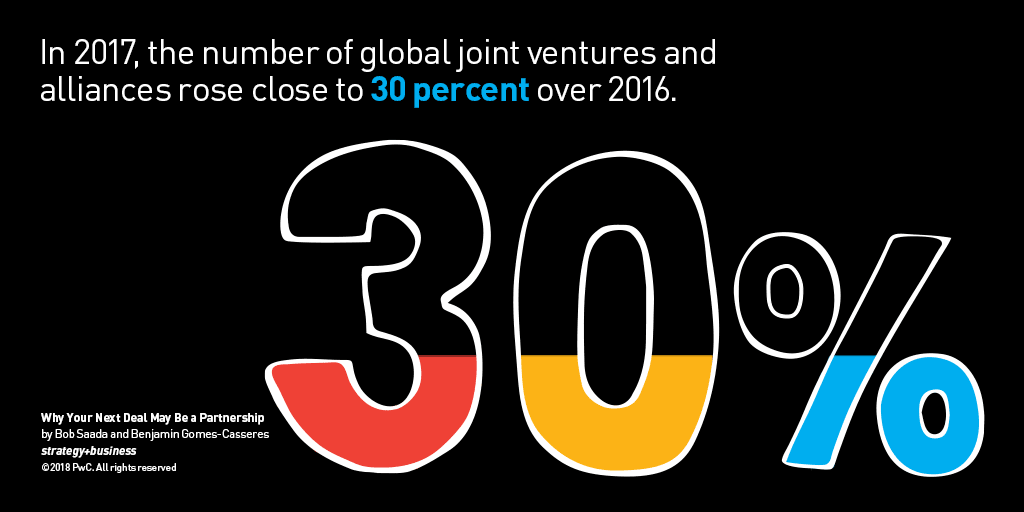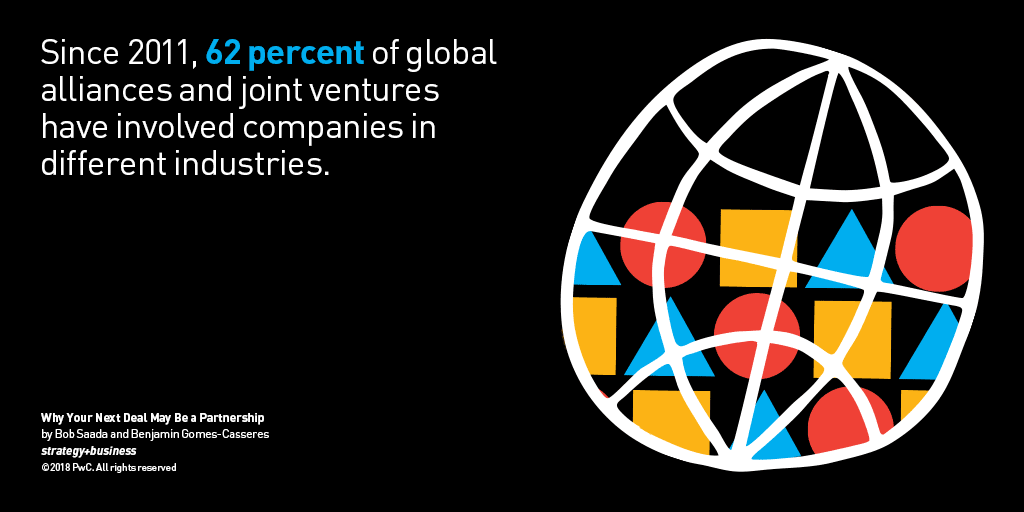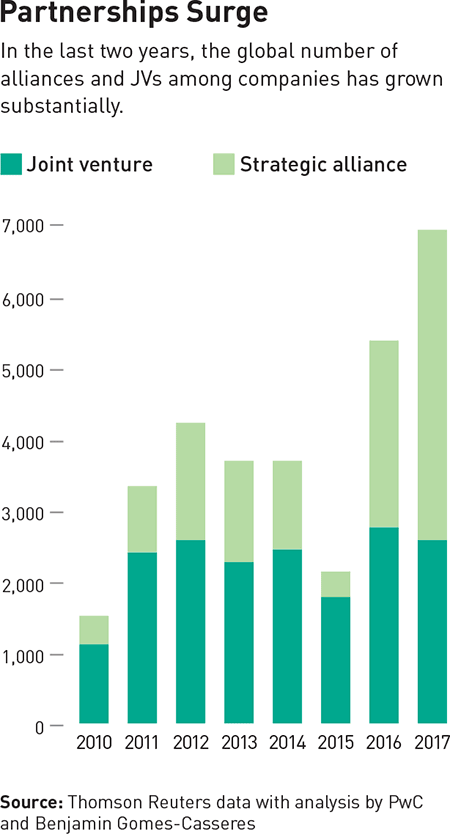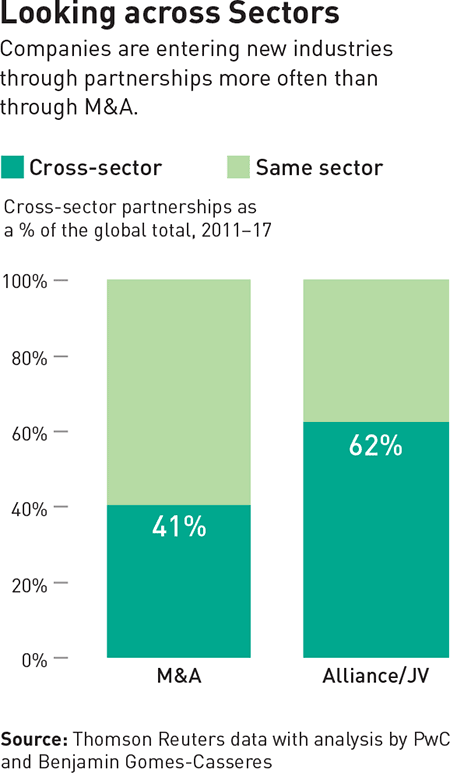Why your next deal may be a partnership
A new study shows that alliances and joint ventures are on the rise worldwide.
A version of this article appeared in the Spring 2019 issue of strategy+business.
When Amazon, Berkshire Hathaway, and JPMorgan Chase announced a new alliance in early 2018, the partnership turned heads. Three companies, giants in their respective industries, were going to pool their resources and work together. The new venture’s goal: targeting waste in the current healthcare system and improving patient service, initially for those covered by the three companies’ health insurance policies, but with the potential to expand.
Partnerships between businesses have a long history and come in many forms, including strategic alliances and joint ventures (JVs). The Amazon–Berkshire–JPMorgan deal shows how companies today, responding to technological disruption, geopolitical uncertainty, regulatory overhaul, and demographic shifts, are pushing such partnerships beyond their traditional limits. The aim is often to bring together expertise to expand the companies’ reach, drive growth, and cope with rising competition. For example, Toyota has invested more than US$5 million in a joint venture with Microsoft that uses the tech company’s cloud computing platform to expand connected car services. Starbucks and Nestlé finalized an alliance in August 2018 through which the latter will sell Starbucks packaged coffee in markets around the globe.


One thing is clear from these and other recent partnerships: Few companies can afford to follow their previous deal blueprints if they want to respond to the disruptions and risks in today’s markets. More important, the traditional lines between industries are blurring, with consumers increasingly expecting goods and services to be interconnected, and businesses seeking to make their supply chains more efficient and effective.
Why a Partnership?
A recent PwC analysis of more than a quarter century of global data on alliances and JVs shows we’re in another period of upswing when it comes to those partnerships. The combined number of alliances and JVs has increased in the past two years and is now at its highest level since the start of the century.
A strategic alliance is an agreement between independent organizations to share resources, knowledge, or other assets. Partners coordinate their actions to pursue mutually beneficial goals while maintaining their autonomy. Each company gains a new business opportunity, be it increasing efficiency, expanding into a new market, capturing more market share, or some other type of growth. A joint venture takes this arrangement a step further, with companies pooling resources to create a separate business entity. JVs are stand-alone enterprises that often share resources with parents, and they’re typically more involved and complex than strategic alliances.
Mergers and acquisitions remain the most common path for companies pursuing inorganic growth. But alliances and JVs provide a way for a company to supplement internal assets and capabilities with access to needed resources, such as distribution channels, capital equipment, and intellectual property, with less investment and risk than the typical M&A. In addition, alliances and JVs can often be executed more quickly than M&A.
Our research found that the use of JVs and alliances varies by industry. Since 1990, asset-heavy industries have generally favored JVs over alliances, because creating separate structures allows the partners to best govern their investments in real assets. These sectors include industrial, consumer and retail, automotive, and energy and mining companies. Alliances, however, have tended to be preferred by information-heavy industries, such as IT; pharmaceuticals; and entertainment, media, and communications businesses. In these sectors, the best way to govern the flow of information has been through contractual structures that don’t require joint ownership of physical assets. IT has seen the most alliances over the past quarter century, and the pharmaceuticals industry is second.
Few companies can afford to follow their previous deal blueprints if they want to respond to the disruptions and risks in today’s markets.
Further evidence of the rise in popularity of alliances and JVs comes directly from company leaders. In PwC’s most recent global CEO Survey, 49 percent of executives said they were planning a new strategic alliance or JV in the next year to help drive corporate growth or profitability. That was more than were planning new M&A activity (42 percent), outsourcing (21 percent), or a business sale or market exit (16 percent).
Companies are also using alliances and JVs to explore growth outside their home countries. Unlike M&A or greenfield investment, an alliance or JV can allow a company to get experience in a particular market before considering a more substantial investment. Although the overall number of cross-border partnerships hasn’t grown in the last quarter century, activity in individual nations has risen and fallen. Japanese firms accounted for more than 25 percent and China-based companies less than 15 percent of early 1990s alliances and JVs. In this decade, however, Japan’s share is less than 10 percent, while Chinese companies are involved in nearly half of all alliances and JVs. The partnership activity of U.S. and European companies has held relatively steady as a share of the total during the same time period.
In a 2017 PwC survey of business leaders in 21 economies that make up the Asia-Pacific Economic Cooperation (APEC), 71 percent said they expected to make greater use of strategic alliances to secure a foothold in foreign markets. If the past is any indication, companies will use alliances and JVs to navigate the modern challenges of globalization and innovation. For example, if M&A is tested by new regulations, alliances and JVs may fill the gap.
Working across Industries
Perhaps the greatest potential for alliances and JVs will come from partnerships that involve companies in different sectors, such as the aforementioned Amazon–Berkshire–JPMorgan deal. For some companies, a full acquisition in a different industry may be too big a commitment. An alliance may allow them to test the waters with less exposure. Executives can place a bet that gives their company access to something new or complementary. If it doesn’t pan out, the company can discontinue the partnership instead of being saddled with a subpar acquisition.
The rise of cross-sector alliances mirrors the trend in M&A, where there has also been a rise in cross-sector transactions — but with alliances and JVs, the trend is even more pronounced. We found that from 2011 to 2017, six out of 10 alliances and JVs have involved companies in different industries, compared with about four out of 10 mergers and acquisitions. Much of today’s cross-industry collaboration is driven by the need for traditional companies to adopt new technologies, or to react to challenges posed by new technologies. That leads car companies to ally with software companies, media companies to join with communications companies, and many other businesses to seek ways to learn and exploit the emerging tools of sophisticated data analytics.
The most common cross-industry trend in our data is the tendency of firms in technology to tie up with firms in other industries. The evolution of computing power, sensors, batteries, and miniaturization has left few industries untouched. These trends have caused even the most well-established companies to look outside their traditional boundaries for innovation. It has led them to set up tech incubators and internal VC arms and to invest in teams that manage alliances.
Cross-sector alliances can take any number of forms. Consider the evolution of mobile phones. As phones became smaller and personal digital assistants were developed, manufacturers and carriers formed partnerships. The arrival of smartphones brought apps and new ways to consume content, leading to other deals. Now we see alliances such as that between T-Mobile and Netflix, with the former gaining a content stream for its mobile customers, while the latter gets access to a new group of subscribers.
Elsewhere, Japanese carmakers and energy companies recently teamed up to build fuel stations for hydrogen fuel cell vehicles, following a similar effort in Germany. Other aspects of the automotive world, such as autonomous vehicles and ride sharing, could invite alliances with insurance companies. Meanwhile, insurance could be a factor in healthcare alliances, as mobile technology and virtual reality change traditional data collection and delivery of care.
The Evolution of a Deal
An alliance may be established and remain just that — two or more companies sharing resources, working toward a common goal, and, ideally, reaping mutual benefits. But it’s also possible that an alliance will evolve into either a different type of partnership or a more traditional M&A. In many cases, a company’s inorganic growth strategy will include a mix of deals, allowing its degree of investment and level of risk to be fluid in each case.
Of course, in some circumstances, the preferences of one or all partners will mean that either an alliance or an acquisition is the only option. But past deals have shown how a relationship can change. The ability of deals to evolve over time can be especially valuable when a business wants to consider entering a new industry or region. If an initial alliance or JV proves fruitful, the company could decide to make a stronger commitment and explore full ownership of the venture, or even a merger.
That’s what happened when the Walt Disney Company ventured into computer-animated films. Pixar was an independent company when it made a deal with Disney in 1991 to produce computer-animated feature films. The first, Toy Story, was released in 1995, and Pixar held an IPO that same year. The two companies continued to work together, and although the relationship was contentious at times, Disney’s strong interest — buoyed by a string of successful films — ultimately led it to acquire Pixar in 2006 for about $7.4 billion.
An alliance can be the tip of the spear when it comes to exploring a new path to growth. High valuations have tested some potential buyers’ willingness to go through with certain acquisitions, fearful the deal won’t deliver an adequate return on investment. But alliances and JVs have proven to be an alternative that provides access to a new market in the short term and keeps the door open for a firmer commitment down the road.
Whatever the path of the partnership, success usually hinges on trust and good management. Building trust early on is important in managing an alliance or JV. It can enable partners to set big long-term goals while celebrating small wins along the way. Companies that manage partnerships well also design agreements that are flexible, coordinate planning and budgeting with each other, and follow strong governance processes and principles. When partners work to be agreeable, collaborative, and responsible, alliances and JVs can thrive.
Author profiles:
- Bob Saada is a partner with PwC US based in New York. He is the U.S. deals practice leader.
- Benjamin Gomes-Casseres is a professor of business strategy at Brandeis University and author of Remix Strategy: The Three Laws of Business Combinations.




